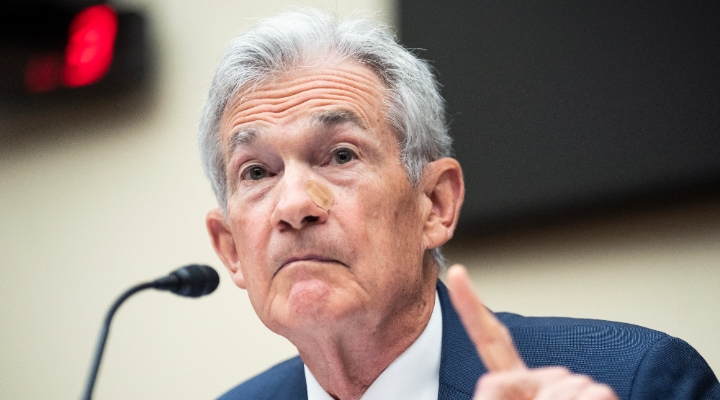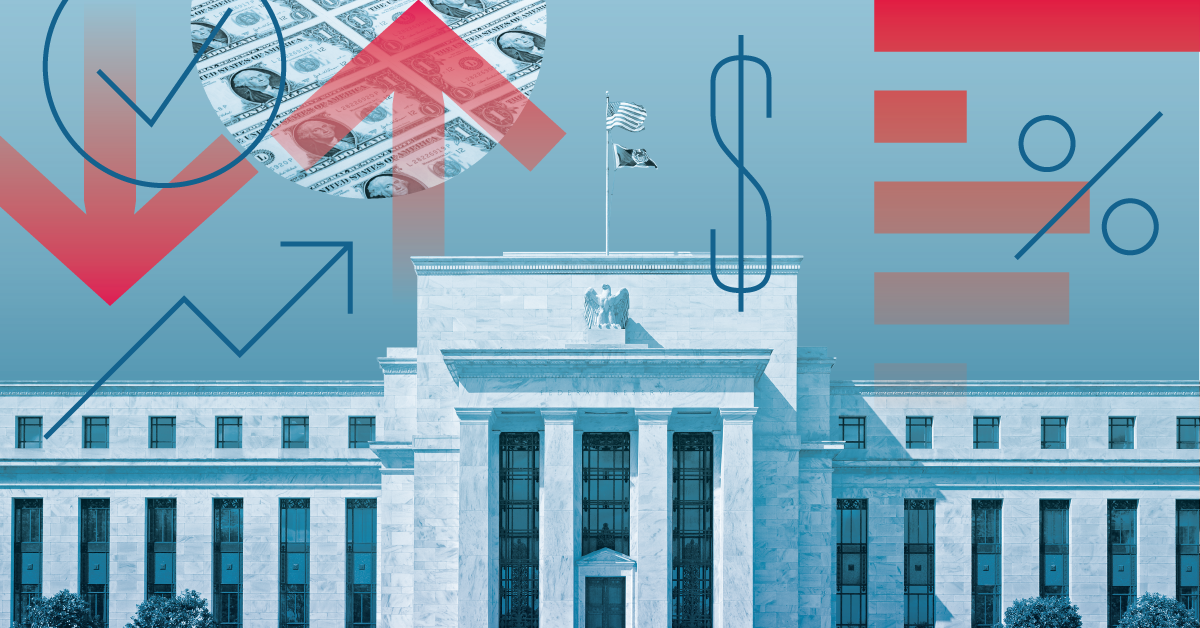
Investors are again recalibrating their expectations around the Federal Reserve’s long-awaited interest rate cuts. After hotter-than-expected jobs market data surprised investors on Friday, Treasury yields spiked and bond futures markets pared back their expectations for policy easing.
While the report showed a reacceleration in hiring, the concern was that too much strength in the job market, coupled with stubborn inflation, could keep the central bank on hold even longer. Bond traders now see a roughly equal chance that rates hold steady or the Fed lowers the funds rate for the first time in this cycle at its September meeting. Before the report, traders pegged the odds of a September rate cut at 55% vs. a 33% chance they’d be held steady.
But despite handwringing over the impact of the so-called “higher for longer” policy on the economy and the equities market, strategists say investors have reason for optimism. In fact, our current scenario—and what’s most likely to come—may propel the powerful bull market, which has seen stocks up nearly 12% in the year to date, to even more gains in the second half.
What to Expect From the Fed’s June Meeting
September aside, the central bank is widely anticipated to hold rates steady at the target range of 5.25%-5.50% at its meeting next week. This consensus was reinforced by Friday’s robust jobs data, which Wells Fargo strategists suggest will keep the Fed in “wait and see” mode.
Anthony Saglimbene, chief market strategist at Ameriprise Financial, expects the Fed to continue its messaging from the past few meetings: “The economy is holding up, services, inflation is still high, and they won’t be ready to start cutting interest rates until they believe inflation is moving back to the 2% target.”
He adds: “I think we’re going to need to see a few more months of inflation sustainably moving lower before the Fed would even entertain cutting interest rates.” May’s CPI report, which will be released on the same day the Fed’s meeting concludes, will give investors more clarity.
When Will the Fed Cut Rates?
When Fed officials meet on Tuesday and Wednesday, it will be against a very different backdrop than just a few months ago. Since the beginning of the year, the outlook for interest rates has changed dramatically. Investors have gone from anticipating six or seven rate cuts this year to just one, or even none. The outlook has shifted due to inflation proving much stickier than expected in January, February, and March.
However, some moderating economic data over the past two weeks has investors adding a little more easing back into the mix. As of Friday, investors saw a roughly 40% chance of a single 0.25% interest rate cut by December, a 36% chance of two cuts, and an 11% chance of three cuts by the end of the year, according to the CME FedWatch tool.
Watching the Dot Plots
Markets, strategists, and even Fed officials have more aligned outlooks for interest rates now than at the beginning of the year. However, the release of the Fed’s June economic projections, known as the dot plots, could upset that balance.
Morningstar chief US economist Preston Caldwell is anticipating two rate cuts beginning in September. Given 2024′s rough start, “The Fed is going to be cautious,” he says, even if inflation continues to improve over the rest of the year. He expects GDP growth to slow gradually over the next year, troughing at 1.5% in 2025. “We should avoid a recession, but with growth slowing well below its potential (2.5%-3.0% over next couple years), sufficient slack should be generated to conclusively win the war against inflation,” he writes in his latest economic outlook.
A Soft Landing Is Ideal for Stock Investors
That slowing growth is not bad, as far as the stock market is concerned. “What I’m forecasting is probably the best case,” Caldwell explains. It’s the rare soft landing—wherein inflation returns to normal while the economy avoids a recession. Growth needs to slow but remain positive to accomplish that.
Caldwell adds that in the short term, a growth slowdown could pressure corporate profits and cause some earnings disappointment. “But that’s going to be a temporary speedbump [for stocks]. Nothing super concerning.
”Ed Clissold, chief US strategist at Ned Davis Research, has reached a similar conclusion. “Moderating, but positive, growth would be the best-case scenario for equities,” he wrote in a Thursday note to clients. He added that a small slowdown would favor large caps rather than small caps, which tend to outperform when growth accelerates. It should also favor growth over value, since growth stocks don’t generally depend on a strong economy for profits.
Two rate cuts happening is also the base case for Kevin Flanagan, head of fixed income strategy at WisdomTree. His ideal scenario for bond investors is three cuts over the remainder of 2024. Falling interest rates tend to be a headwind for bonds, whose prices rise as their yields fall.
No Rate Cuts? Stocks Can Take the Pressure, but More Pain for Bonds
Even in a scenario in which the Fed doesn’t cut rates at all this year, investors still have reason for optimism. “The market’s looking at profit growth and a strong economy,” explains Saglimbene.
While some cracks are starting to show, especially among lower-income consumers, the economy has thus far been able to absorb the impact of the central bank’s historic policy-tightening cycle. “It’s not like we’ve seen in other rate cut cycles where the Fed is cutting rates because of the economy faltering,” adds Flanagan.
In today’s economy, Saglimbene says, “If the Fed isn’t cutting interest rates, it’s because the economy is holding up stronger than expected.” That’s positive for stocks. “Stocks historically perform well when the Fed is not doing anything,” he adds. “We’re in one of those periods right now.
”It’s another story entirely for bond investors. For Flanagan, the worst-case scenario is that the Fed doesn’t cut rates at all in 2024. High interest rates tend to weigh on bond prices. If that happens, “the bond market is going to shift its focus to 2025,” he says. The Fed remaining data-dependent for longer could mean more volatility in fixed-income markets as investors seek clarity on rates.
Flanagan also points out that a prolonged period of bond yields at today’s levels is not abnormal over the past decades, excluding the 15 years when the Fed kept rates low following the financial crisis. “These are normal yield levels, but a lot of people aren’t used to it … it’s a huge, different dynamic in the market.”
Slowing Economic Growth Could Dent Stocks
On the other hand, growth slowing too much could cause problems for stocks. “The stock market would perform poorly if these higher restrictive rates start taking a more sudden bite of economic activity,” Saglimbene says. “The bear case is the Fed leaves interest rates too high or too restrictive for too long,” damaging the economy.
“That could mean the Fed has to really move aggressively,” according to Caldwell, who says this recessionary scenario is “more possible than people think.” He says it’s even conceivable (though unlikely) that the federal funds rate could drop to zero again. That may sound nice for asset prices, but the recession precipitating such a dramatic rate reduction wouldn’t be.
Sticky Inflation Could Lead to Economic Overheating
On the other end of the spectrum, it’s possible economic growth won’t slow as much as expected while inflation remains stickier than the Fed would like. The central bank’s target for the PCE Price Index (its preferred measure of inflation pressures) is 2%. As of April, PCE inflation was 2.7%. Caldwell says it would be a problem if inflation stays closer to 3% rather than continue to fall.
This type of overheating is “a very credible scenario for what could happen as a result of the internal momentum in the economy right now,” he explains. The resulting uncertainty around the path of monetary policy could also weigh on asset prices.





.jpg)













